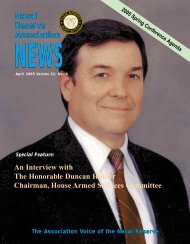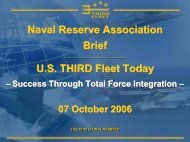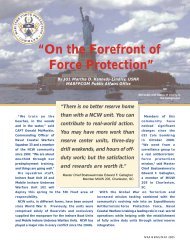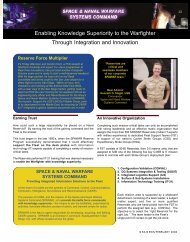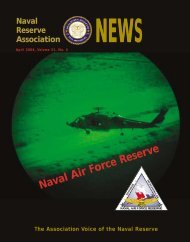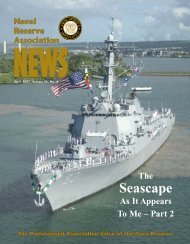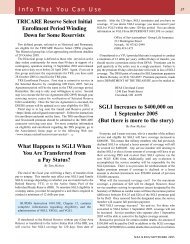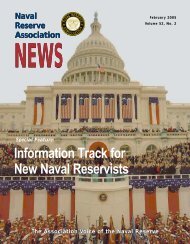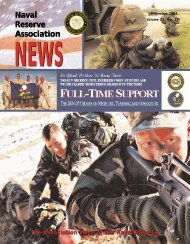Naval Reserve Association
Naval Reserve Association
Naval Reserve Association
Create successful ePaper yourself
Turn your PDF publications into a flip-book with our unique Google optimized e-Paper software.
24Lettersin the fleet augmentation units. The on-going reorganization onlyappears “lopsided,” to use his term, to someone using an obsoletevision of the reserve component. We are not competitors of theactive component. We are colleagues.CDR Quisenberry asks why Navy <strong>Reserve</strong> end strength isbeing cut from FY05 to FY06 “when almost all other <strong>Reserve</strong>Components are working toward size increases.” The proposedFY06 budgets show no increase in SELRES or Guard endstrength among any of the armed services. The Air Force’sreserve component (USAFR and Air Guard) will see a cut ofslightly more than one percent, while the Army, MarineCorps, and Coast Guard selected reserve end strength remainsconstant.Not withstanding bright spots such as the Coastal Warfarecommunity, a much better question is “Why are so few Navy<strong>Reserve</strong> capabilities mobilized in time of war?” Granted, a goodpart of the answer lies in the geography of current operations:there’s not much salt water in Iraq and even less in Afghanistan.Nevertheless, almost four years after the start of offensiveoperations, the Navy <strong>Reserve</strong> has only begun to redefine andreorganize itself to better meet the needs of the Navy and thenation’s security. I say, not a moment too soon.I put forth that none of us in the Navy <strong>Reserve</strong> should be surprisedat the cuts. To demand an explanation for the cuts in end strengthis to reduce the Navy <strong>Reserve</strong> to little more than a federaljobs program. The fact of that matter is that the Navy <strong>Reserve</strong> isplaying, relative to the other services, a minor role, albeit a veryimportant one. According to the Department of Defense, on 22June 2005 there were 3,311 Navy <strong>Reserve</strong> sailors mobilized, orabout four percent of Navy SELRES FY2005 end strength.Compare that with 124,550 mobilized Army <strong>Reserve</strong> and Guardsoldiers, or about 22.4 percent of end strength. The Marine Corps<strong>Reserve</strong> numbers are similar to the Army’s: 9,578 Reservistsmobilized, over 24 percent of end strength. As shown in the chartbelow, the percentage of the Air Force reserve component andCoast Guard <strong>Reserve</strong> mobilized exceeds that of the Navy<strong>Reserve</strong>.continue to play an ancillary role in Iraq and Afghanistan. Butwe, the leaders in the Navy <strong>Reserve</strong>, need to match the capabilitieswe provide to the missions and responsibilities the Navy willassume as new threats emerge from over the horizon. Thatprocess has only begun.One final point: CDR Quisenberry uses the term “blogg” (sic)to mean, roughly, “garbage.” Actually, the term blog is a shortenedform of the word “Web log.” A Web log is a Web-based publicationconsisting primarily of periodic articles.Dear Admiral Keith,Charles S. GramagliaLieutenant Commander, USN(RC)Thank you so much for publishing CDR Doyle Quisenberry’sarticle about the <strong>Naval</strong> <strong>Reserve</strong> name change in the July 2005NRA News. I agree 100 percent with him, and you will note myletterhead is also representative of my designator pin, MerchantMarine Officer USNR (1625 Deck).However, CDR Quisenberry missed another glaring slap in theface to all Reservists that many may NOT be aware of. That is theNational Cemetery System’s refusal to recut, VERBATIM, myfather’s head stone in Arlington National Cemetery. (I was willing toBUY a new head stone after my mother died and was buried withhim in 1997). Unfortunately, they would have aborted his 28years of USNR service to “Captain, USN.” Needless to say, I didNOT renew his head stone. Further, I now have serious doubtsabout choosing to be buried through a system that would ignoremy 35 years, 11 months, and 11 days USNR service, this over aperiod in excess of 42 years. (Yes, there is time in there as QM3also).All Reservists, as well as NRA members, and their familiesshould be aware of this National Cemetery policy, PRIOR to theirloved ones having to deal with more disgusting governmentbureaucracy during their time of sorrow.Edward Faith White, Jr.Captain, USNR (Ret)Dear Admiral Keith,The last column is particularly damning from a budgetaryperspective. I expect Congress is very aware of the number ofSELRES salaries that are being paid per mobilized reservist.Although the table above provides merely a snapshot of a dynamicstatistical picture, since the liberation of Iraq these numbers havebeen surprisingly consistent. And even at the height of the Navy’smobilization in June 2003, only 12.5 percent of the (FY2004)SELRES end strength was mobilized. Clearly, the Navy willCDR Quisenberry pretty well hit the nailon the head with his article. While I feellike a kid, having only 39 years service,compared to his 42, I have seen bias towardsthe <strong>Reserve</strong>s since I was on active dutyteaching boot camp in 1966, and at sea in67-70. My <strong>Reserve</strong> AT’s usually started off, on arrival, with “oh,you’re a <strong>Reserve</strong>.” The <strong>Reserve</strong> bias was still alive and well whenI retired in December 2004. One thing the CDR overlooked – BigNavy has been telling us the truth all along – “One Navy.” Whenthe <strong>Reserve</strong>s are gone, there will only be . . . “One Navy.”Michael A. BrueckmannCommander, CEC, USNR (Ret)NRA NEWS/SEPTEMBER 2005



